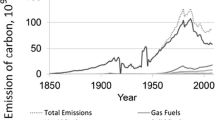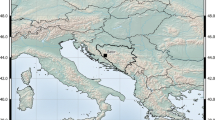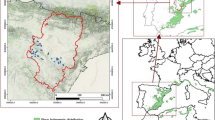Abstract
Plant communities with Dwarf pine (Pinus mugo var. pumilio) form characteristic vegetation in the subalpine belt of the Giant Mountains (Krkonoše, Karkonosze and Riesengebirge, Czech Republic). This “island” of arcto-alpine tundra represents the northernmost edge of Dwarf pine natural range. We asked how concentration of sulphur in needles, growth, healthy status and fructification changed over three decades (1981–2011) with different air pollution in differently aged (45–120 years) autochtonous and allochtonous (introduced from the Alps) Dwarf pine stands. Different Dwarf pine stands above the alpine timberline were able to withstand 1980s, the period of heavy air pollution, without any decrease in growth rate or remarkable decrease in healthy status. Dwarf pine is thus highly tolerant to deposition of sulphur compounds. High concentration of SO2 in the air positively affected sulphur concentration in needles and eliminated thus sulphur deficiency. Higher germination rate of seeds in 2000s in comparison with 1980s indicate that the air pollution could decrease germination ability of seeds. High insect outbreaks (by Thecodiplosis brachyntera and Neodiprion sertifer) in 1990s and 2000s caused decrease in needle year classes. As there was a gradual increase in mean annual temperature over years 1981–2011, Dwarf pine stands can be more and more endangered by insect outbreaks in the future. There was no remarkable difference between autochtonous and allochtonous stands in all measured growth, healthy status and fructification characteristics. To determine real effects of air pollution and insect outbreaks on Dwarf pine stands from year to year fluctuations, decade-long monitoring is necessary.









Similar content being viewed by others
References
All JN, Benjamin DM (1975) Influence of needle maturity on larval feeding preference and survival of Neodiprion swainei and N. rugifrons on jack pine, Pinus banksiana. Ann Entomol Soc Am 68:579–584
Bäck J, Huttunen S, Turunen M, Lamppu J (1995) Effects of acid rain on growth and nutrient concentrations in scots pine and norway spruce seedlings grown in a nutrient-rich soil. Environ Pollut 89:177–187
Barbeito I, Dawes MA, Rixen CH, Senn J, Bebi P (2012) Factors driving mortality and growth at treeline: a 30–year experiment of 92 000 conifers. Ecology 93:389–401
Boratyńska K, Marcysiak K, Boratyński A (2005) Pinus mugo (Pinaceae) in the Abruzzi Mountains: high morphological variation in isolated populations. Bot J Linn Soc 147:309–316
Büntgen U, Frank DC, Kaczka RJ, Verstege A, Zwijacz–Kozica T, Esper J (2007) Growth/climate response of a multi-species tree-ring network in the Western Carpathian Tatra Mountains, Poland and Slovakia. Tree Physiol 27:689–702
Büntgen U, Kaczka RJ, Trnka M, Rigling A (2012) Ensemble estimates reveal a complex hydroclimatic sensitivity of pine growth at Carpathian cliff sites. Agr Forest Meteorol 160:100–109
Butterbach-Bahl K, Gundersen P (2011) Nitrogen processes in terrestrial ecosystems. In: Sutton MA, Howard CM, Erisman JW, Billen G, Bleeker A, Grennfelt P, Van Grinsven H, Grizzetti B (eds) The European nitrogen assessment. Cambridge University Press, Cambridge, pp 99–124
Christensen KL (1987) Taxonomic revision of the Pinus mugo complex and P. rhaetica (P. mugo sylvestris) (Pinaceae). Nord J Bot 7:383–408
Dässler HG (1981) Einfluß der Luftverunreinigungen auf die Vegetation. Ursachen, Wirkungen, Gegenmaßnahmen. – VEB Gustav Fischer Verlag. Jena
Dullinger S, Dirnböck T, Grabherr G (2004) Modelling climate change-driven treeline shifts: relative effects of temperature increase, dispersal and invasibility. J Ecol 92:241–252
Dullinger S, Dirnböck T, Köck R, Hochbichler E, Englisch T, Sauberer N, Grabherr G (2005) Interactions among tree-line conifers: differential effects of pine on spruce and larch. J Ecol 93:948–957
Falusi M, Calamassi R, Tocci A (1983) Sensitivity of seed germination and seedling root growth to monture stree in four provenances of Pinus halepensis Mill. Silvae Genet 32:4–9
Forbis TA (2003) Seedling demography in an alpine ecosystem. Am J Bot 90:1197–1206
Frank D, Esper J (2005) Characterization and climate response patterns of a high-elevation, multi-species tree-ring network for the European Alps. Dendrochronologia 22:107–121
Germino MJ, Smith WK, Resor AC (2002) Conifer seedling distribution and survival in an alpine-treeline ecotone. Plant Ecol 162:157–168
Giménez-Benavides L, Escudero A, Pérez-García F (2005) Seed germination of high mountain Mediterranean species: altitudinal, interpopulation and interannual variability. Ecol Res 20:433–444
Glynn C, Lindelöw A (2002) Defoliation by the Needle-shortening pine gall midge, Thecodiplosis brachyntera, on Pines in Central Sweden. Scand J Forest Res 17:150–157
Grace J (1990) Cuticular water loss unlikely to explain tree-line in Scotland. Oecologia 84:64–68
Gray EA, Rennie JC, Waldrop TA, Hanula JL (2002) Patterns of seed production in table mountain pine. pp 302–305 In: Outcalt KW (ed) Proceedings of the eleventh biennial southern silvicultural research conference. Gen Tech Rep SRS–48. Asheville, NC: US Department of Agriculture, Forest Service, Southern Research Station, p 622
Hošek J, Schwarz O, Svoboda T (2007) Výsledky desetiletého měření atmosférické depozice v Krkonoších. Opera Corcontica 44:179–191
Hueck K (1939) Botanische Wanderungen im Riesengebirge. Pflanzensoziologie 3:1–116
Ikeda T, Matsumura F, Benjamin DM (1977) Mechanism of feeding discrimination between matured and juvenile foliage by two species of pine sawflies. J Chem Ecol 3:677–694
Jankovská V (2001) Vegetation development in the western part of the Gianth Mts. during the holocene (Pančavské rašeliniště mire—palaeoecological research). Opera Concortica 38:11–19
Jeník J (1961) Alpinská vegetace Krkonoš, Kralického Sněžníku a Hrubého Jeseníku. Vydavateľstvo ČSAV, Praha, p 412
Körner C (1998) A Re-assessment of high elevation treeline positions and their explanation. Oecologia 115:445–459
Kullman L (1996) Rise and demise of cold-climate Picea abies forest in Sweden. New Phytol 134:243–256
Kullman L (2007) Tree line population monitoring of Pinus sylvestris in the Swedish Scandes, 1973–2005: implications for tree line theory and climate change ecology. J Ecol 95:41–52
Lokvenc T (2001) History of the Giants Mts’ dwarf pine (Pinus mugo Turra ssp. pumilio Franco). Opera Corcortica 38:21–42
Lokvenc T, Minx A, Nehyba J, Stejskal O (1994) Rekonstrukce porostů kleče horské (Pinus mugo Turra) v Krkonoších. Opera Corcontica 31:71–92 (in Czech)
Mueller-Dombois D, Ellenberg H (1974) Aims and methods of vegetation ecology. Wiley, NY, p 547
Oberhuber W (2004) Influence of climate on radial growth of Pinus cembra within the alpine timberline ecotone. Tree Physiol 24:291–301
Pacalaj M, Longauer R, Krajmerová D, Gömory D (2002) Effect of site altitude on the growth and survival of Norway spruce (Picea abies L.) provenances on the Slovak plots of IUFRO experiment 1972. J Forest Sci 48:16–26
Petterson F, Högbom L (2004) Long-term growth effects following forest nitrogen fertilization in Pinus sylvestris and Picea abies stands in Sweden. Scand J Forest Res 19:339–347
Rohmeder E (1972) Das Saatgut in der Forstwirtschaft. Hamburg und Berlin, Verlag Paul Parey 273 pp
Savva Y, Oleksyn J, Reich PB, Tjoelker MG, Vaganov EA, Modrzynski J (2006) Interannual growth response of Norway spruce to climate along an altitudinal gradient in the Tatra Mountains, Poland. Trees 20:735–746
Slovik S, Siegmund A, Kindermann G, Riebeling R, Balázs A (1995) Stomatal SO2 uptake and sulfate accumulation in needles of Norway spruce stands (Picea abies) in Central Europe. Plant Soil 168–169:405–419
Son Y, Lee JH, Chung YJ (2007) Temperature-dependent post-diapause development and prediction of spring emergence of the pine needle gall midge (Dipt., Cecidomyiidae). J Appl Entomol 131:674–683
Souček J, Lokvenc T, Vacek S, Štursa J (2001) Site and stand conditions of dwarf pine stands. Opera Corcontica 38:43–61
Soukupová L, Frantík T, Jeník J (2001) Grassland versus krumholz in arctic-alpine tundra of the Giant Mountains. Opera Corcontica 38:63–76
Švajda J, Solár J, Janiga M, Buliak M (2011) Dwarf Pine (Pinus mugo) and Selected abiotic habitat conditions in the Western Tatra Mountains. Mt Res Dev 31:220–228
ter Braak CJF, Šmilauer P (2002) CANOCO reference manual and CanoDraw for Windows user’s guide: Software for Canonical Community Ordination (Version 4.5). Microcomputer Power, Ithaca, New York
Tesař V (1982) Přestavba lesa postiženeho imisemi. [Regeneration targets and substitute forest stands in air polluted areas.] In: Obnova lesa v imisnich oblastech. Praha, ČAZ: 75–80
Treml V, Ponocná T, Büntgen U (2012) Growth trends and temperature responses of treeline Norway spruce in the Czech-Polish Sudetes Mountains. Climate Res 55:91–103
Vacek S, Hejcman M (2012) Natural layering, foliation, fertility and plant species composition of a Fagus sylvatica stand above the alpine timberline in the Giant (Krkonoše) Mts., Czech Republic. Eur J Forest Res 131:799–810
Vacek S, Lepš J (1987) Changes in the horizontal structure in a spruce forest over a 9-year period of pollutant exposure in the Krkonoše mountains, Czechoslovakia. For Ecol Manage 22:291–295
Vacek S, Podrázský V, Mikeska M, Moser WK (2003) Introskeletal erosion threat in mountain forests of the Czech Republic. J Forest Sci 49:313–320
Vacek S, Podrázský V, Mikeska M, Schwarz O, Simon J, Boček M, Minx T (2006) Lesy a ekosystémy nad horní hranicí lesa v národních parcích Krkonoš. Folia Forestalia Bohemica, Lesnická práce 2, pp 112
Vacek S, Matějka K, Simon J, Malík V, Schwarz O, Podrázský V, Minx T, Tesař V, Anděl P, Jankovský L, Mikeska M (2007) Health stand and dynamics of forest ecosystems in the Krkonoše Mts. under the air-pollution stress. Kostelec nad Černými lesy, Lesnická práce: 216. (in Czech)
Vacek S, Hejcmanová P, Hejcman M (2012) Vegetative reproduction of Picea abies by artificial layering at the ecotone of the alpine timberline in the Giant (Krkonoše) Mountains, Czech Republic. For Ecol Manage 263:199–207
Virtanen T, Neuvonen S, Nikula A, Varama M, Niemelä P (1996) Climate change and the risks of Neodiprion sertifer outbreaks on Scots pine. Silva Fen 30:169–177
Wild J, Winkler E (2008) Krummholz and grassland coexistence above the forest-line in the Krkonose Mountains: grid-based model of shrub dynamics. Ecol Model 213:293–307
Wilmking M, Hallinger M, Van Bogaert R, Kyncl T, Babst F, Hahne W, Juday GP, de Luis M, Novak K, Völlm C (2012) Continuously missing outer rings in woody plants at their distributional margins. Dendrochronologia 30:213–222
Zeidler M, Duchoslav M, Banaš M, Lešková M (2012) Impacts of introduced dwarf pine (Pinus mugo) on the diversity and composition of alpine vegetation. Community Ecol 13:213–220
Acknowledgments
We are deeply grateful to Ing. Theodor Lokvenc, CSc. for his long-term data collection assistance and valuable comments. The research was supported by the Grant TA02020873.
Author information
Authors and Affiliations
Corresponding author
Additional information
Communicated by A. Weiskittel.
Rights and permissions
About this article
Cite this article
Vacek, S., Hejcmanová, P., Hejcman, M. et al. Growth, healthy status and seed production of differently aged allochtonous and autochtonous Pinus mugo stands in the Giant Mts. over 30 years. Eur J Forest Res 132, 801–813 (2013). https://doi.org/10.1007/s10342-013-0721-2
Received:
Revised:
Accepted:
Published:
Issue Date:
DOI: https://doi.org/10.1007/s10342-013-0721-2




